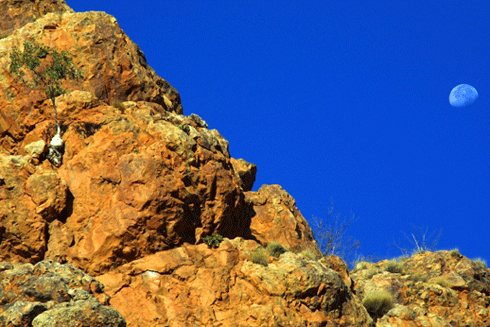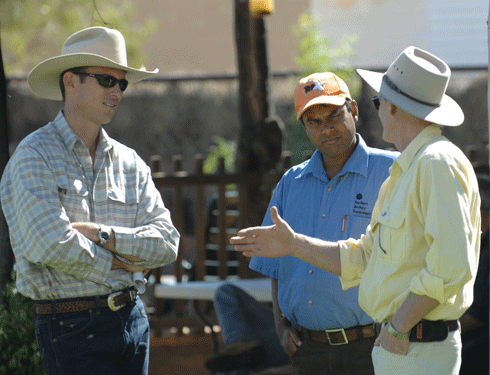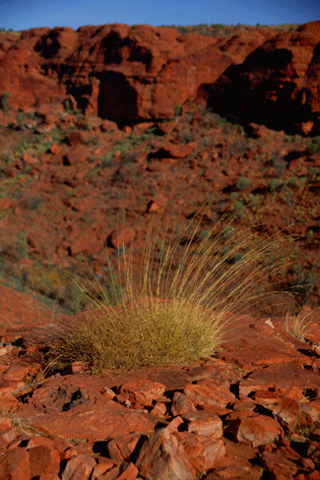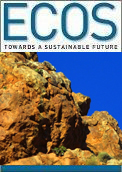
|
Published: 13 February 2012
The science of desert living: building livelihoods and protecting landscapes
The ‘science of desert living’ is a new area of research that investigates livelihoods and opportunities for the people and landscapes of the desert. Local knowledge and cultural difference are the drivers of the development of desert Australia.

|
|
Desert landscapes and their relationship to desert livelihoods are the focus of a new research field, the ‘science of desert living’.
Credit: Ninti One
|
Deserts are special: not only for the rich life they contain and the intricacy of their functioning, but also for the unique ways in which humans adapt to desert living.
Living in deserts is challenging enough in itself, but is made harder still by:
-
marked cultural differences
-
distinctive local knowledge
-
social uncertainty
-
isolation from centres of political and economic decision.
These are features of ‘desert syndrome’, described by our colleague Dr Mark Stafford Smith in a 2008 paper in the The Rangeland Journal . Dr Stafford Smith’s paper invites us to take an entirely fresh perspective on how we manage and care for our deserts and their people. His ground-breaking work has led to a flowering of new research into the science of desert living: research that investigates livelihoods and new opportunities for the people and landscapes of the desert. Here, we provide an overview of some of the most exciting findings in this distinctively Australian field of research, as profiled in a recent issue of The Rangeland Journal .
An enormous diversity of enterprises – both market and non-market – provides livelihoods for desert dwellers, including bush foods, desert ecotourism, land management, energy and water, mining, education, health care and small business.
Dr Barrie Pittock argues that climate variability and remoteness – until now, seen as barriers to the advancement of economies and settlements under existing transport and energy systems – may provide a launch pad for new enterprises and livelihoods founded on renewable solar and geothermal energy. Examples include large ‘farms’ exporting energy to the industrial centres, and relocation of energy-intensive industries to deserts, where energy is cheap, reliable and plentiful. While Australians have tended to regard these as pie-in-the-sky ideas, the scale of current investment suggests otherwise.
The resources boom is forecast to result in a requirement for 170,000 new workers by 2016. Unlike coastal Australia, the deserts have a growing number of young Aboriginals ready to join the workforce locally. Dr Yiheyis Maru and Dr Jocelyn Davies found that while there are many employment opportunities in regions such as Anmatjere in Central Australia, they are often filled by migrants or fly-in/fly-out workers, leaving local Aboriginal people unemployed or under-employed. This appears to be due to perceptions in the wider community that Aboriginal people in remote areas inevitably lack the skills or motivation to work, and are welfare dependent. However, Drs Maru and Davies find that social networks play an important role in creating employment opportunities for Aboriginal people – and that having people with strong cross-cultural skills in brokering roles can make a big difference. Increased use of such people in these roles can help to develop jobs profiled around Aboriginal cultural norms – and acquaint young Aboriginals better with industry norms.
Dr Elizabeth Ganter finds that there is high mobility of Aboriginal people from government to the ‘Indigenous sector’ and back. She argues that Aboriginal public servants who seek to substantively represent Aboriginal people often experience tension – either with the terms of their employment or with their communities. This tension and mobility leaves many Aboriginal people neither inside nor outside, but somewhere at the edges of government. Dr Ganter concludes that in seeking to improve representation of Aboriginal people in governance, the focus should shift from direct employment to fostering collaboration between government and Aboriginal organisations.
The two-speed nature of the Australian economy provides both opportunities and problems for remote communities. New jobs are appearing in the resources sector, but workers are lured away from other parts of the economy – especially the public sector – raising the cost of housing and other services in remote areas. Historically, it has been difficult to attract and retain workers in remote locations. Professor Fiona Haslam McKenzie finds that the most effective strategies used by industries and sectors to attract employees are those that provide proper facilities and give ‘incomers’ a sense of being part of the community.
Other research into ‘desert syndrome’ shows how respecting and valuing the drivers of local knowledge and cultural difference can create more effective livelihoods. Dr Jocelyn Davies and her co-authors discuss health outcomes from Aboriginal management of remote lands. They propose four principles that would give Aboriginal people a greater sense of control over their land, culture and destiny, and lead to livelihoods that promote better health:
-
governance recognises and respects Aboriginal custom and tradition
-
learning is embraced as a lifelong process
-
relationships are recognised as very important
-
partnerships are based on priorities that all parties agree on.
Rangeland managers need to respond to a range of highly variable external environmental, political and socio-economic drivers. Dr Michael LaFlamme develops a framework that clarifies the learning process for rangeland managers and highlights the benefits of collaboration. His framework focuses on the monitoring of six key assets – landscape, biodiversity, flexibility, skills, information and networks. Rangeland groups can use this model to work together to develop more secure lives in our increasingly unpredictable environment.
The strong association of Aboriginal people with land means that they gain more than cultural benefits from working on country. The health and wellbeing benefits from this activity have been described in qualitative terms in numerous studies. Mr David Campbell’s research reveals a range of private and public benefits, including:
-
better physical and mental health for individuals
-
preservation of culture
-
maintenance of Australian biodiversity
-
reduced healthcare costs.
The highly variable nature of the Australian desert means that bush food harvesting enterprises often experience a boom–bust cycle, which prevents large-scale commercial development. Central to developing these enterprises is the empowerment of social networks, which are in the control of Aboriginal harvesters. Dr Fiona Walsh and Ms Josie Douglas (a CSIRO Indigenous Research Fellow) argue that one of the most important benefits of livelihoods in bush foods is their link to social and cultural integrity, language, and land management: all of which benefit health and wellbeing.
Dr Doris Schmallegger and Professor Dean Carson find that a number of factors prevent desert enterprises diversifying from staple industries (e.g. food, fibre, mining) into areas such as tourism and rangeland management. One of the most important is the ability to attract, train and retain skilled staff in remote locations. Cultural differences can also hinder the acceptance of new ways and opportunities, while local knowledge is needed to run such businesses effectively.

|
|
Collaboration between government and Aboriginal organisations may be the key to fostering better representation of Aboriginal people in economic development opportunities.
Credit: Ninti One
|
Taken together, these studies underline the closely interwoven character of livelihoods, culture and landscapes in desert Australia. They also point to a number of tensions and constraints that hinder desert development, but which – if clearly understood – can be overcome. The work also emphasises the difference between jobs, enterprises and livelihoods in deserts compared with those of urban or coastal Australia. In deserts, for example, success is more likely if there is a marriage of economic activity with cultural, social and traditional features of life.
Encouragingly, the studies show that increasing numbers of young Aboriginal people are seeking opportunities to work in new livelihoods in ways that preserve their culture and way of life in desert settings. Opportunities in areas such as landscape management and conservation, tourism, art, bush foods, carbon sequestration, and renewable energy and services offer promising ways to combine public good with individual benefit. In taking advantage of these opportunities, it is important to reinforce the preservation and passing on of cultural knowledge, and to strengthen the links between older community members and the younger generation. This groundbreaking work provides essential insights into the future economic development of desert Australia – insights that are being built on by the work of organisations such as Ninti One Ltd and the CRC for Remote Economic Participation.
Ninti One is a not-for-profit national company set up specifically to tackle social and economic disadvantage, and to improve the lives and economic opportunities of people living in the remote and desert regions of Australia. Ninti One’s business is the discovery, management and delivery of knowledge aimed at achieving a brighter future for desert and remote people and their communities.




